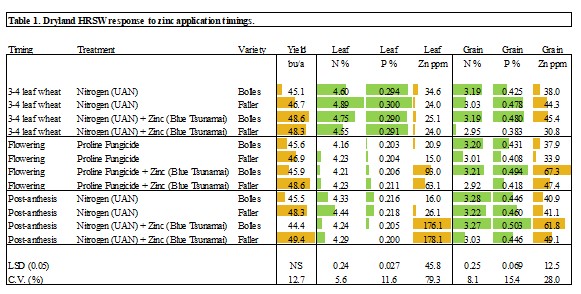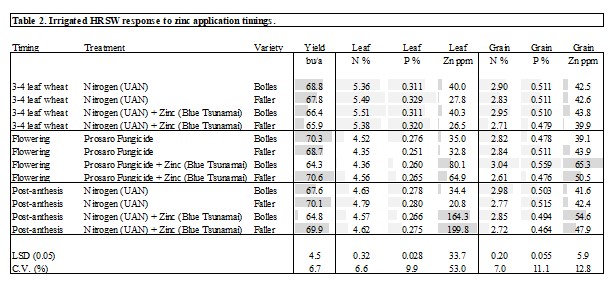Introduction
Biofortification is an emerging strategy that increases the nutrient content of food crops. Wheat, rice, and corn are common crops that are targeted for biofortification efforts. One of the common goals of biofortification is a food system-wide increase in key micronutrients, especially in countries with widespread malnutrition. The amount of desired nutrient content (biofortification) varies by average consumption of a product within a country, so that the grain nutrient concentration increases average intake of the nutrient. This could be considered similar to providing a vitamin supplement on a large scale.
Zinc is one of the primary nutrients utilized in biofortification strategies. Zinc deficiency is common in some parts of the world, including India and Southeast Asia. One of the primary ways to increase zinc concentration in grain is to use varying management strategies. This can be accomplished through soil-applied fertility management, in-season nutrient applications, or through plant breeding efforts. A good benchmark for a grain to be considered zinc biofortified is a zinc concentration of 45 mg/kg in the kernels.
North Dakota hard red spring wheat (HRSW) is already considered high quality and often marketed at a premium compared to other wheat types. It is only natural for this class of wheat to be considered for biofortification purposes. Areas that grow HRSW may apply inputs that are not as common in other areas of the country or world, including post-anthesis nitrogen applications and sometimes multiple fungicide applications. Initial information has indicated that wheat grown under standard conditions in North Dakota often contains between 30-45 mg/kg zinc. Could zinc products be added to these applications to increase grain zinc concentration? Confirmation of zinc fortification would lead to new marketing opportunities for HRSW.
Methods
Studies were conducted in 2020 and 2021 in dryland and irrigated environments to test different application timings of zinc to HRSW which could be paired with existing passes across a field. These timings were herbicide timing, scab fungicide timing, and post-anthesis nitrogen timing. At each timing, the standard input was applied with or without a zinc product. A zinc EDTA (Blue Tsunami) was used with the applications. Huskie was the herbicide used in the first timing, which also included UAN. Prosaro fungicide was used for the scab timing and UAN was used in the post-anthesis timing. Tissue samples were collected one week after application to test for increases to zinc content in the plants. Grain samples were also tested for zinc concentration. The study included a high yielding (Faller) and high protein (Bolles) variety to test if nutrient partitioning changed with varieties. The study was arranged as a split-split-plot randomized complete block design (RCBD), with timing being the main plot, variety as the subplot, and zinc as the sub-sub-plot.
Results
Results from the dryland and irrigated studies could not be combined, but the years could be combined. Results are presented as either dryland or irrigated and include both years. For the dryland site, yield was not impacted by any of the treatment combinations (Table 1). Leaf nitrogen and phosphorous concentrations did not change with the addition of zinc. At the early timing, leaf zinc concentrations also did not increase. However, leaf zinc concentrations did increase with the latter two applications, with the highest concentration at post-anthesis timing. There were no differences between variety accumulation of zinc. For the grain concentration, there again was no accumulation of zinc at the early timing but increases at the later two timings. The largest benefit was realized using the variety Bolles, which was statistically greater than the zinc concentration of Faller. However, Faller zinc concentration was still greater than the no-zinc treatment and increased to a point that could be considered biofortified.
Table 1. Dryland HRSW response to zinc application timings.
The irrigated environment performed similarly (Table 2). There was less variability in the data which led to yield differences between treatments, but only between varieties. Neither leaf nor grain zinc concentration increased at the earliest application timing. Leaf concentration of zinc once again was greatest at the post-anthesis application timing, but also increased at the fungicide timing. Grain zinc concentration was greatest at the fungicide application timing for Bolles. Faller had no difference between application timings. Both Bolles and Faller reached zinc concentrations that could be considered biofortified.
Table 2. Irrigated HRSW response to zinc application timings.
Some take-aways from this study are that in all four environments tested, both Bolles and Faller responded to zinc applications. Bolles often had a better response. This could mean that protein-oriented varieties may be better suited for biofortification strategies or it could be some other factor in the genetics between the varieties. Leaf zinc concentrations were greatest with the post-anthesis timing, but much of that zinc did not translocate to the grain. Applying zinc with the fungicide was the most reliable method for increasing grain zinc concentration in the study.
It would be important to test this theory on additional varieties to confirm whether there are differences in responses. However, this study confirmed the potential to fortify HRSW with the addition of zinc during the growing season. This could be a new value-added value added product that would be suited for export as either raw or processed to many parts of the world that are looking for more nutrient dense diets.
Partial support for this research was provided by the National Wheat Foundation and the Grain Foods Foundation.


